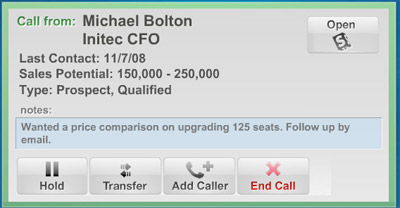VoIP desktop phone design runs Android
Aug 24, 2009 — by Eric Brown — from the LinuxDevices Archive — 111 viewsA San Francisco-based startup announced an Android-based VoIP desktop phone for business users. Powered by a Texas Instruments OMAP SoC and a SIP-ready AudioCodes VoIP processor, Cloud Telecomputers' reference platform offers an 8-inch, 800 x 600 touchscreen, handset, Bluetooth, HD speakerphone, and an open, Android-based “Glass” development platform.
The Glass platform is designed for SIP phone and IP PBX manufacturers, as well as service providers, says Cloud Telecomputers. The company is said to be in the process of certifying Glass to be compatible with IP PBX systems including Asterisk and Trixbox, as well as hosted VoIP systems from BroadSoft and MetaSwitch. In addition, the Glass software can be ported to other hardware configurations and processors, says the company.
Available now to partners, with phones expected to arrive in the first quarter of 2009, the Glass hardware platform combines an application processor and a separate VoIP processor. Each processor is configured with its own RAM, flash memory, and peripherals. Communications between the two processors is available via an internal IP network, says Cloud Telecomputers.

Cloud Telecomputers' Glass reference design
The VoIP processor, meanwhile, is an unnamed AudioCodes part, probably the MIPS32-based AC494E or AC496E. The AudioCodes processor is said to offer a proven, tested SIP stack, with a DSP (digital signal processor) that runs voice codecs and echo-canceling software. The processor's wideband speech codecs use the 7.1KHz band instead of the usual 3.4KHz voice spectrum, doubling bandwidth and significantly elevating voice quality, claims Cloud Telecomputers.

Another view of the Glass design

Simplified Glass block diagram
A Bluetooth radio allows users to answer cell-phone calls on the Glass phone, and both RJ-11 and a 2.5mm headset jacks are available. The phone can be powered via Power over Ethernet (POE).

Glass phonebook interface
- Instant screen-sharing — This remote-access feature enables remote callers to view activities on a computer screen in real-time by uploading the screens to a proprietary, password-protected URL
- Visual voicemail — This GUI interface to voice mail is said to let users see a list of messages, listen to messages, delete them, and perform other voicemail tasks without using voice prompts.
- Voice to text — Enables users to read voicemails instead of listening to them.
- Voice notes — Users can record short messages or task-lists, and then view them later via the voice-to-text feature.
- Salesforce.com integration — The Glass phone can integrate with the Salesforce.com CRM software to pull up real-time contact management information about a client and account as they are calling or receiving a call (see image below).

Glass Salesforce.com integration
In either case, third-party developers can write Glass/Android apps for the platform. Presumably, generic Android apps can also run on the phones without much modification, although the company is not clear on this point.

Calendar functions and web widgets
(Click to enlarge)
- Hardware design and schematics
- CAD drawings, bill of materials, and other items
- Firmware and onboard software
- Linux-based API for custom interface development
- Android development environment, enabling partners and third parties to write custom applications that may or may not employ the API
- Windows and Mac client software for integrating Outlook syncing, tap-to-dial, screen-sharing, Salesforce.com integration, etc.
- Access to "cloud-based ecosystem for hosted services," which may be offered by licensees alone or in partnership with Cloud
- Access to "future developments"
VoIP telephony server and client functions
The Glass platform also ships with a telephony server application that runs on the AudioCodes processor. The server is remotely accessible over the internal IP network, enabling it to accept commands over TCP/IP, such as "make call," says Cloud Telecomputers. The server can also send event notifications asynchronously to the OMAP processor, such as "incoming call."
A telephony client application, meanwhile, runs on the OMAP SoC, for controlling and communicating with the telephony server. The client exposes an API for integrating Android, enabling Android app access to telephony functions.
The AudioSense VoIP stack provides all SIP/SDP related functions, including asynchronous callback handling, SIP registration, and call initiation, and also handles call states and multiple calls, says the company. Other PBX-like functions are said to including call handling, transfer, and conference features.
The VoIP stack also includes a media stack via RTP/RTCP modules, so Android apps only need to handle requests and notifications, says Cloud Telecomputers. Developers can run the Android Emulator on a connected desktop and connect to the VoIP processor's IP address for access.
Stated one of Cloud Telecomputer's "angel" investors, Ed Zander, former CEO of Motorola, "I love this phone. It's like having a smartphone on my desk." Other investors include Ken Oshman, founder of Rolm Corp., inventor of the first digital PBX, and Bob Hawk, ex-group president of Qwest.
Stated Ravin Suri, Cloud Telecomputers CTO, "Our approach allows us to focus on innovation, continually increasing the functionality of the Glass platform, while our partners concentrate their resources on branding, selling and tailoring applications for vertical markets."
Availability
The Glass hardware and software platform is now available to partners at an undisclosed price, with Glass-enabled phones expected to ship in the first quarter of 2010. Suggested retail prices for commercial phones are expected to range between $600 and $700.
More information may be found here.
This article was originally published on LinuxDevices.com and has been donated to the open source community by QuinStreet Inc. Please visit LinuxToday.com for up-to-date news and articles about Linux and open source.